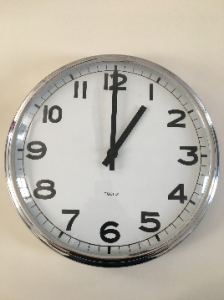5.4 Um wie viel Uhr hast du Kurse?

Hallo alle zusammen!
Zum Aufwärmen machen wir unseren Tagesminiplausch und eine Wiederholung.
Wiederholung
In the previous lesson, you learned how to ask someone about their course load and when they have class. You also learned to say when you have class. Let’s review.
What two questions did you just review from the previous lesson? Jot those down now and practice saying them aloud.
Lektionsüberblick
In the previous lesson, you learned how to ask when someone has classes. Today we will move into asking more specific questions about time and providing more specific time-related answers. Let’s get started—Die Uhr tickt (the clock is ticking 🙂). Soon you will be able to 1) ask someone when they have class, 2) state the start and end times of your courses, and 3) talk about your schedule.
Was weißt du schon?
Let’s do our regular skills check before beginning.
| Noch nicht start klar?
Du kannst immer auf die gleiche 1010-Lektion zurückgreifen! |
Not confident about starting this lesson?
You can always review the same Lektion from 1010. |
1) Ask when someone has class
You’ve learned how to ask generally when a friend or classmate has classes – Wann sind deine Kurse?
Now, let’s get specific. Listen and read the question below. Based on the image clue, can you guess the meaning?
 |
Um wie viel Uhr hast du Kurse? |
Let’s practice putting the parts of the question together.
2) Die Kurszeiten
Let’s learn to say the start and end times of our classes. Oftentimes, classes do not start and end at the hour so you will need to be comfortable with the numbers in between, especially numbers like thirty (dreizig), fifty (fünfzig), or even forty-five (fünfundvierzig). Take a moment to review larger numbers like these in the video[1] .
If you were taking classes in Germany, the times of the classes would be listed using the 24-hour clock. You can return to Lektion 5.4 in Deutsch im Alltag to review how to work with that format.
Let’s practice telling time. Read, listen, and repeat the times you see below.
To say the start and end times, you will need to know two small German words: von and bis. See if you can tell what they mean.
 |
Johannes sagt, “Mein Deutschkurs ist von 9 bis 9hr50.” | |
 |
Julia sagt, “Mein Spanischkurs ist von 10 bis 11hr30.” |
Let’s practice.
Jetzt bist du dran!
Now record this in German in your audio journal. If you can do it immediately without reading, that’s great! Otherwise, practice saying it a couple times before recording. Or rerecord, if you are not satisfied.
You can quickly improve your German time telling skills, if you do this several times throughout the day.
Stuttgart im Blickpunkt
Spätzle sind Eierteigwaren aus Mehl, Salz und Ei mit unregelmäßiger Form, die als Beilage oder mit weiteren Zutaten (wie Käse, Speck, usw.) als eigenes Gericht serviert werden. Spätzle haben in der Region Schwaben, wo Stuttgart liegt, eine jahrhundertelange Tradition der Herstellung bis ins 18. Jahrhundert zurück. Traditionell werden Spätzle von Hand geschabt.
Spätzle are a type of egg pasta made of flour, salt, and egg in an irregular shape, which are typically served as a side dish or as its own dish with other ingredients (like cheese, bacon, etc.) Spätzle have a long tradition (from the 18th century) in the Swabian region. Traditionally, Spätzle are scraped manually on a board.
3) Say what classes you have each day and when
Let’s put it all together. Read and listen to the comic below.
 |
Let’s practice.
Jetzt bist du dran!
Zum Schluß

*As you conclude this lesson, don’t forget to check Canvas!*

Media Attributions
- 1020-banner-large-reduced
- Photos of clocks from Grenzenlos Deutsch, licensed under a Creative Commons Attribution-NonCommercial-ShareAlike 4.0 International License
- Image of Johannes from Grenzenlos Deutsch, licensed under a Creative Commons Attribution-NonCommercial-ShareAlike 4.0
- Image of Julia from Grenzenlos Deutsch, licensed under a Creative Commons Attribution-NonCommercial-ShareAlike 4.0 International License
- Comic made at www.MakeBeliefsComix.com
- Deutsche Zahlen Von 1 Bis 100 by Deutsch Lernen in Deutschland, licensed by CC-BY International License. ↵

